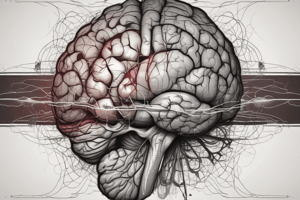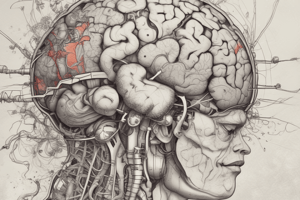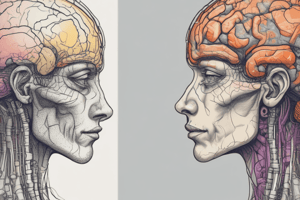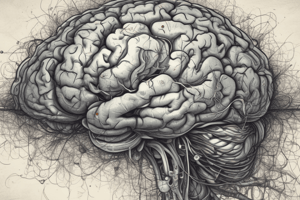Podcast
Questions and Answers
What factor is most critical in affecting the outcome of trauma to the brain and spinal cord?
What factor is most critical in affecting the outcome of trauma to the brain and spinal cord?
- Location and severity of injury (correct)
- Age of the patient
- Gender of the patient
- Presence of external head wounds
Why might an injury to the frontal lobe be clinically silent?
Why might an injury to the frontal lobe be clinically silent?
- The frontal lobe heals faster than other brain areas.
- There are fewer neurons in the frontal lobe.
- The frontal lobe is protected better than other areas.
- The frontal lobe has fewer vital functions. (correct)
What is a contrecoup injury?
What is a contrecoup injury?
- An injury occurring near the spinal cord.
- An injury occurring at the site of the impact.
- An injury occurring at the opposite side of the impact site. (correct)
- An injury occurring at the base of the brain.
Which type of brain injury might occur without visible external head injuries?
Which type of brain injury might occur without visible external head injuries?
What morphological shape do brain contusions typically have?
What morphological shape do brain contusions typically have?
In which brain regions are contusions most common?
In which brain regions are contusions most common?
What is a characteristic feature of old traumatic brain lesions?
What is a characteristic feature of old traumatic brain lesions?
What are the manifestations of acute contusions in the temporal lobes?
What are the manifestations of acute contusions in the temporal lobes?
What type of brain hemorrhage can occur directly following CNS trauma?
What type of brain hemorrhage can occur directly following CNS trauma?
Which symptom is NOT a direct consequence of contrecoup injuries?
Which symptom is NOT a direct consequence of contrecoup injuries?
What vessels are primarily involved in epidural hematomas in children and adults?
What vessels are primarily involved in epidural hematomas in children and adults?
What is the typical clinical progression for a patient with an epidural hematoma after a traumatic event?
What is the typical clinical progression for a patient with an epidural hematoma after a traumatic event?
What is the immediate medical treatment required for an expanding epidural hematoma?
What is the immediate medical treatment required for an expanding epidural hematoma?
Where do subdural hematomas most often manifest?
Where do subdural hematomas most often manifest?
What is the primary cause of subdural hematomas?
What is the primary cause of subdural hematomas?
What is the most common time frame for subdural hematomas to become manifest after injury?
What is the most common time frame for subdural hematomas to become manifest after injury?
What are the typical symptoms of a subdural hematoma?
What are the typical symptoms of a subdural hematoma?
How does an acute subdural hematoma typically appear morphologically?
How does an acute subdural hematoma typically appear morphologically?
What type of hematoma results from disruption of bridging veins?
What type of hematoma results from disruption of bridging veins?
What type of hematomas are most likely to occur at sites of contusions and lacerations?
What type of hematomas are most likely to occur at sites of contusions and lacerations?
Flashcards are hidden until you start studying




